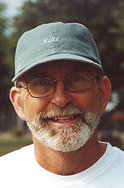 |

Tennis Anyone
September 2006
Article
Contact John Mills
Latest Tennis Anyone Article
Tennis Anyone Archives:
2003 - Present
1994 - 2002
Tennis Server
HOME PAGE
Do You Want To Be A Better Tennis Player? Then Sign Up For A Free Subscription to the Tennis Server INTERACTIVE
E-mail Newsletter!
 You will join 13,000 other subscribers in receiving news of updates to the Tennis Server along with monthly tennis tips from tennis pro Tom Veneziano.
You will join 13,000 other subscribers in receiving news of updates to the Tennis Server along with monthly tennis tips from tennis pro Tom Veneziano.
Best of all, it is free!
|
 |
TENNIS FEATURES: |
 |
TENNIS COMMUNITY: |
 |
EXPLORE THE TENNIS NET: |
|
 | |

 |
Some Doubles Do's

John Mills, USPTA |
When you receive a ball at the net that you can be aggressive with, attack the closest opponent to you.
When you are being attacked, try to deflect the ball away from the player who is attacking you.
If you or your partner hit a good lob, which goes over your opponent's heads, follow that lob to the net, at least the service line, and do not let their return of your lob bounce.
If you get pulled wide outside the court, hit that ball down the line, not cross court, whether you hit a ground stroke or a lob.
If you are receiving a high ball when you are at the net, say "Mine" as soon as possible. This will free up your partner to move in to join you and not be wondering behind you while you think about making the shot.
If you cannot cover the high ball, forcing your partner to go get it, cross over and move back. This is important because, if your partner hits a weak shot back, you will become the target.
Serve more often into the body of the receiver or toward the center of the court. This sets your partner up to poach.
Poach only if you think you can win the point.
When players are coming at you, keep the ball low.
Low is what wins in doubles.
Do not lob the ball when you are moving forward.
Lob because you are being thrown outside the court wide or deep.
Most of your serve returns, approach shots, half volleys and low volleys should go cross court to the deep player.
Most of the high floating volleys, easy overheads and easy high bouncing balls (kill shots) that you reach at the net, should be hit at the closest opponent to you. This stops their ability to lob so much.
The majority of shots in doubles should and do go down the middle of the court.
If you receive a high lob from your opponent when you are on the baseline, try to take it in the air before it bounces. This will prevent you from losing position, give your opponents less time to gain the offensive and possibly allow you to come to the net to gain the offense.
As is always true, placement over power.
Your number one friend in a match is the "unforced error" from you opponent.
If you cannot win the point, try to set your partner up to win the point. It is a team sport.
If you are losing to a team that is staying back, pushing and lobbing, pull them toward you with short shots. This will force them into territory that they are not as familiar with.
Good luck on the courts!
  
Tennis Anyone Archives:
1994 - 2002 | 2003 - Present
If you have not already signed up to receive our free e-mail
newsletter Tennis Server INTERACTIVE, you can sign up here.
You will receive notification each month of changes at the Tennis
Server and news of new columns posted on our site.
|
This column is copyrighted by John Mills, all rights reserved.
John Mills' experience includes four years as head pro at the Windemere Racquet & Swim Club, where he was responsible for organization of all tennis activities at the club. John also played college tennis at the University of Houston and has spent 20 years teaching tennis at the Memorial Park Tennis Center, the Pasadena Racquet Club, and as the head pro at the Bay Area Racquet Club.
|
 |
|

|





 You will join 13,000 other subscribers in receiving news of updates to the Tennis Server along with monthly tennis tips from tennis pro Tom Veneziano.
You will join 13,000 other subscribers in receiving news of updates to the Tennis Server along with monthly tennis tips from tennis pro Tom Veneziano. 